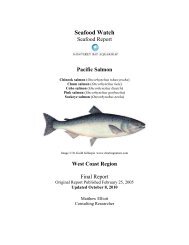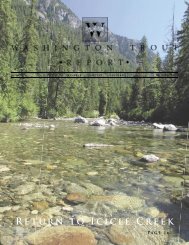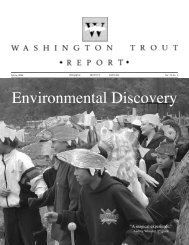Whidbey Island Near Shore Research Project
Washington Trout Report - Wild Fish Conservancy
Washington Trout Report - Wild Fish Conservancy
- No tags were found...
Create successful ePaper yourself
Turn your PDF publications into a flip-book with our unique Google optimized e-Paper software.
Advocacy Updates;<br />
The Wild Salmon Recovery Initiative<br />
by Ramon Vanden Brulle, WT Communications Director<br />
The Wild Salmon Recovery Initiative is an umbrella<br />
program, under which almost all of Washington Trout’s<br />
conservation-advocacy initiatives are funded and<br />
implemented. The overall goal of the WSRI is to influence<br />
better salmon management and recovery policies at the<br />
state and federal levels, and to monitor and attempt to<br />
enforce compliance with provisions of the Endangered<br />
Species Act.<br />
The WSRI attempts to ensure that hatchery,<br />
harvest, and recovery management will be as transparent,<br />
thorough, accurate, and as biologically and legally credible<br />
as possible. WT efforts have added teeth and accountability<br />
to regulatory processes that otherwise may have been pro<br />
forma and ineffective. Bureaucracies move slowly, and<br />
these processes will continue to play out over the next<br />
several months and years, but efforts under the program<br />
have already replaced deliberate delay and inaction with<br />
forward progress.<br />
Hatchery Proposals in Puget Sound and the<br />
Columbia Basin<br />
Through 2004 and the beginning of 2005, WSRI<br />
staff have taken effective advantage of established and<br />
created public-input opportunities to improve and help<br />
shape regional salmon-recovery management proposals.<br />
WT efforts influenced NOAA Fisheries to prepare<br />
Environmental Impact Statements before approving harvest<br />
and hatchery plans, and influenced WDFW to expand<br />
public-input opportunities in its hatchery management.<br />
Back in 2003, WT reached a settlement agreement<br />
with WDFW over two federal lawsuits alleging that<br />
WDFW hatchery programs in Puget Sound were violating<br />
the Endangered Species Act by harming and killing listed<br />
salmon through competition, displacement, predation, and<br />
harmful genetic interactions. The settlement set a schedule<br />
for the submission of outstanding Hatchery and Genetic<br />
Management Plans, required for populations listed under<br />
the ESA, and expanded the opportunity for public review<br />
of all HGMPs.<br />
WT submitted comments to WDFW reflecting<br />
concern that the Puget Sound hatchery program is too<br />
large to responsibly accommodate the level of uncertainty<br />
presented in the HGMPs. The HGMPs displayed a repeated<br />
failure to describe clear program goals, justifications,<br />
performance standards, monitoring and evaluation<br />
protocols, or timetables. In general, WT found the<br />
hatchery plans inadequate to warrant ESA authorization,<br />
and recommended that WDFW withdraw them for<br />
significant revision, and/or consider scaling back or<br />
discontinuing many of its Puget Sound hatchery programs.<br />
WDFW responded to public comments by committing<br />
to developing and identifying measurable hatchery<br />
performance standards, and to developing monitoring<br />
programs to measure hatchery performance. (See WT<br />
Report, spring 2004; “Making Hatcheries Safe for Salmon<br />
Recovery.”)<br />
In July 2004, WT submitted comments to<br />
NOAA fisheries regarding the scope of a pending<br />
Environmental Impact Statement that will review the<br />
two Resource Management Plans for Puget Sound region<br />
hatchery programs, and the HGMPs reviewed by WT in<br />
2003. We recommended that NOAA evaluate the RMPs<br />
and individual hatchery plans to determine how they<br />
reconcile with existing and emerging hatchery-reform<br />
recommendations, including the recent findings of the<br />
Columbia River Power and Conservation Planning<br />
Council’s Independent Science Advisory Board and the<br />
Hatchery Science Review Group. We suggested that<br />
NOAA adopt firm timelines, performance standards, and<br />
enforcement mechanisms for hatchery-reform efforts.<br />
Our comments promoted several potential alternatives to<br />
the proposed RMPs, and other issues that NOAA should<br />
consider in the EIS, including: replacing or supplementing<br />
hatchery programs with habitat preservation/restoration;<br />
full implementation of the HSRG recommendations; full<br />
implementation of WDFW’s Wild Salmonid Policy; a<br />
decrease in artificial production in selected programs; and<br />
establishing non-hatchery watersheds as references for<br />
analyzing impacts of hatchery production. The EIS and a<br />
final NOAA determination on the Puget Sound hatchery<br />
plans are expected this year.<br />
In July 2004, Washington Trout submitted<br />
comments on a Draft Environmental Impact Statement<br />
issued by WDFW for a new juvenile steelhead acclimation<br />
and rearing facility on the Skagit River. WDFW is<br />
proposing to rear and release 334,000 hatchery steelhead<br />
at either Grandy Creek or the Baker River, and another<br />
200,000 at existing facilities at Barnaby Slough and the<br />
Marblemount Hatchery in the upper river.<br />
WDFW claims that the total target for steelhead<br />
releases in the Skagit is already 534,000, but total Skagit<br />
River hatchery-steelhead releases over the last eleven years<br />
have averaged only 418,000, including years when broodcollection<br />
and egg-take targets were significantly exceeded,<br />
suggesting that the current program may be unable to meet<br />
the smolt target. While the DEIS frankly admits that if the<br />
project is delayed or deferred, the program will continue to<br />
fall short of production goals, it still asserts that releasing<br />
534,000 hatchery fish into the Skagit River does not need<br />
to be evaluated, because it is an “existing condition,” but<br />
10






